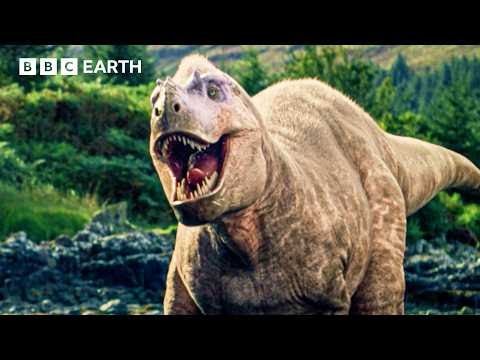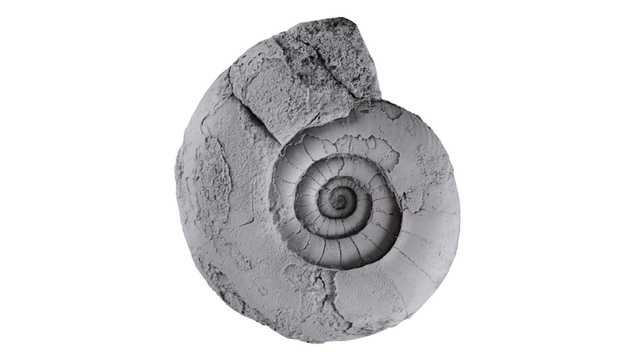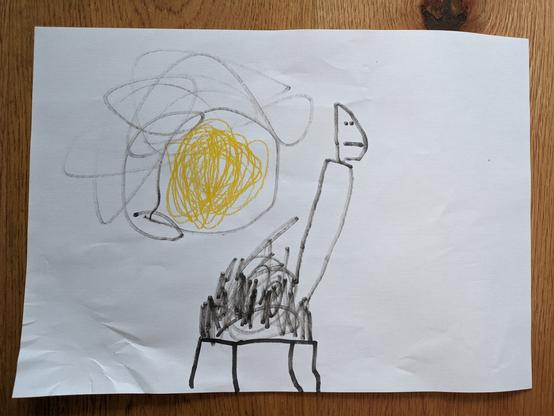Keto or paleo...and why..?
Trailer k Putování s dinosaury 2 je venku už pár hodin! Vypadá úžasně, že? Toto bude jeden z nejlepších #paleo dokumentů celého desetiletí!
#walkingwithdinosaurs #wwd2 #dinosaurs #bbcearth #prehistory #nature #wildlife #animals #fossils #paleontology
https://blogorgonopsid.blogspot.com/2025/04/vysel-trailer-k-putovani-s-dinosaury-2.html
The trailer for Walking with Dinosaurs 2 has been out for a few hours now! It looks amazing, doesn't it? This is going to be one of the best #paleo #documentaries of this whole decade!
#walkingwithdinosaurs #wwd2 #dinosaurs #bbcearth #prehistory #nature #wildlife #animals #fossils #paleontology
https://blogorgonopsid.blogspot.com/2025/04/vysel-trailer-k-putovani-s-dinosaury-2.html
Le trou temporel inexplicable de la préhistoire
Super vidéo sur une question que je ne m'étais jamais posée. Je découvre cette chaîne et elle a l'air passionnante
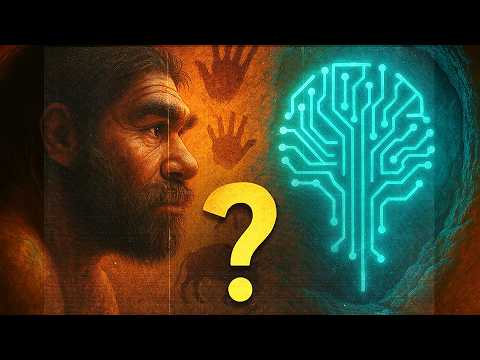
Le trou temporel inexplicable de la préhistoire
#NewSpecies!
New ordovician coiled cephalopod from #germany just came in:
Trocholites vortex
Treatment: https://treatment.plazi.org/id/03AD87B1-DD3B-4252-311D-9EB4940BFDCF
Publication: https://doi.org/10.5852/ejt.2025.982.2843
#ejtaxonomy #TrocholitesVortex
#FAIRdata
#science #OA #openaccess #biology #taxonomy #ecology #biodiversity #nature #wildlife #conservation #animals #malacology #cephalopods #fossils #paleo #paleontology #ordovician
"The Right’s ‘Natural’ Meat Obsession Is a Regressive Fantasy" by @sentientmedia
<💬>
Another component for Kennedy of what constitutes “natural” is taking on things like red food dye, seed oils and ultra-processed foods — while promoting tallow, raw milk and grass-fed beef.
</💬>
https://sentientmedia.org/mahas-natural-foods-obsession/
Vegans often are faced with fallacious arguments, and one of the most common is the Naturalistic fallacy.
https://en.wikipedia.org/wiki/Naturalistic_fallacy
However, this is often a bad faith disguise. The use of naturalistic fallacies in these contexts, such as the claim that consuming animals is "good" because it's natural, is a disguise for another more insidious fallacy: the traditionalist fallacy or "appeal to tradition".
https://simple.wikipedia.org/wiki/Appeal_to_tradition
The traditionalist fallacy is, in this context, the argument that "consuming animals is good because we've done it for thousands of years".
Traditionalism is heavily political, as the people are finding out again in places such as the US. It's sometimes known as "paleoconservatism", and it should be no surprise that the popularity of the "paleo diet" culturally connects to this.
Conservatives, ever since the rise of modernity (end of 'traditional' society, end of monarchism and feudalism) have been trying to reinvent the past through pseudointellectual and pseudoscientific efforts. This has been at the heart of incredible amounts of suffering and horror since then. I have some notes on that on my pinned thread: https://veganism.social/deck/@veganpizza69/110813538364525265
Bullshit & snake oil are not vegan.
#MAHA #meat #grassFed #animalIndustry #CAFO #intensivization #extensivization #sustainability #fascism #ecofascism #conservatism #traditionalism #paleoconservatism #paleo #paleodiet #traditions #tradwife #pseudoscience #scam #antivaccine #antivaxx #grifters #sustainability #snakeoil
Loving the discussion surrounding this @PNASNews publication on Phanerozoic #paleo #temperature evolution, one of the most interesting #paleoclimate discussions in my opinion.
https://www.pnas.org/doi/10.1073/pnas.2400434121
Critique: 6-10 degrees #tropical #ocean #temperatures during the #Ordovician seem very low to me, especially considering that in this time (450 million years ago) corals were thriving. The critical comment by Ethan Grossman and colleagues therefore seems fitting.
Our new paper looks into systematic changes in higher-order moments of temperature and precipitation distributions based on 💻 simulations of the 27000 years of climate. This is interesting, because from the 🧊 Glacial Maximum 21 thousand years ago to today the 🌍 warmed by around 5 degrees🌡️, leading to the loss of ice sheets over the Deglaciation, and culminating in the warm Holocene -- every step of the way led to changes in climate dynamics 🌬️ 🌄.
https://cp.copernicus.org/articles/21/627/2025/
Thanks to @bmbf_bund @soef_bmbf for funding and our great collaborators in Hamburg @MPI_Meteo, Leeds, Bristol, Bern
A contribution to the Palmod project www.palmod.de 🎉
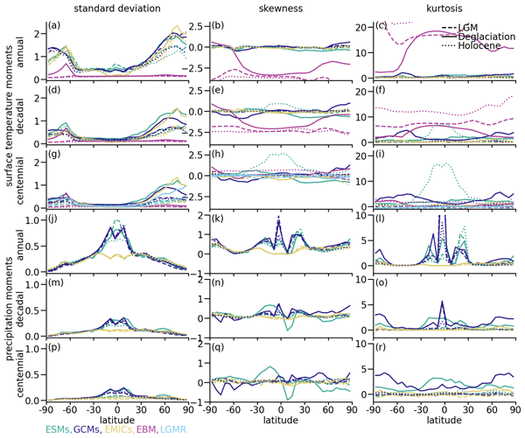
Patterns of changing surface climate variability from the Last Glacial Maximum to present in transient model simulations
Abstract. As of 2023, global mean temperature has risen by about 1.45±0.12 °C with respect to the 1850–1900 pre-industrial (PI) baseline according to the World Meteorological Organization. This rise constitutes the first period of substantial global warming since the Last Deglaciation, when global temperatures rose over several millennia by about 4.0–7.0 °C according to proxy reconstructions. Similar levels of warming could be reached in the coming centuries considering current and possible future emissions. Such warming causes widespread changes in the climate system, of which the mean state provides only an incomplete picture. Instead, fluctuations around the mean and in higher-order statistics need to be considered. Indeed, climate's variability and the distributions of climate variables change with warming, impacting, for example, ecosystems and the frequency and intensity of extremes. However, previous investigations of climate variability focus mostly on measures such as variance, or standard deviation, and on quasi-equilibrium states such as the Holocene or Last Glacial Maximum (LGM). Changes in the tails of distributions of climate variables and transition periods such as the Last Deglaciation remain largely unexplored. Therefore, we investigate changes of climate variability on annual to millennial timescales in 15 transient climate model simulations of the Last Deglaciation. This ensemble consists of models of varying complexity, from an energy balance model to Earth system models (ESMs), and includes sensitivity experiments, which differ only in terms of their underlying ice sheet reconstruction, meltwater protocol, or consideration of volcanic forcing. The ensemble simulates an increase in global mean temperature of 3.0–6.6 °C between the LGM and Holocene. Against this backdrop, we examine whether common patterns of variability emerge in the ensemble. To this end, we compare the variability in surface climate during the LGM, Deglaciation, and Holocene by estimating and analyzing the distributions and power spectra of surface temperature and precipitation. For analyzing the distribution shapes, we turn to the higher-order moments of variance, skewness, and kurtosis. These show that the distributions cannot be assumed to be normal, a precondition for commonly used statistical methods. During the LGM and Holocene, they further reveal significant differences, as most simulations feature larger temperature variance during the LGM than the Holocene, in line with results from reconstructions. As a transition period, the Deglaciation stands out as a time of high variance in surface temperature and precipitation, especially on decadal and longer timescales. In general, this dependency on the mean state increases with model complexity, although there is a large spread between models of similar complexity. Some of that spread can be explained by differences in ice sheet, meltwater, and volcanic forcings, revealing the impact of simulation protocols on simulated variability. The forcings affect variability not only on their characteristic timescales. Rather, we find that they impact variability on all timescales from annual to millennial. The different forcing protocols further have a stronger imprint on the distributions of temperature than precipitation. A reanalysis of the LGM exhibits similar global mean variability to most of the ensemble, but spatial patterns vary. However, paleoclimate data assimilation combines model and proxy data information using a Kalman-filter-based algorithm. More research is needed to disentangle their relative impact on reconstructed levels of variability. As such, uncertainty around the models' abilities to capture climate variability likewise remains, affecting simulations of all time periods: past, present, and future. Decreasing this uncertainty warrants a systematic model–data comparison of simulated variability during periods of warming.
